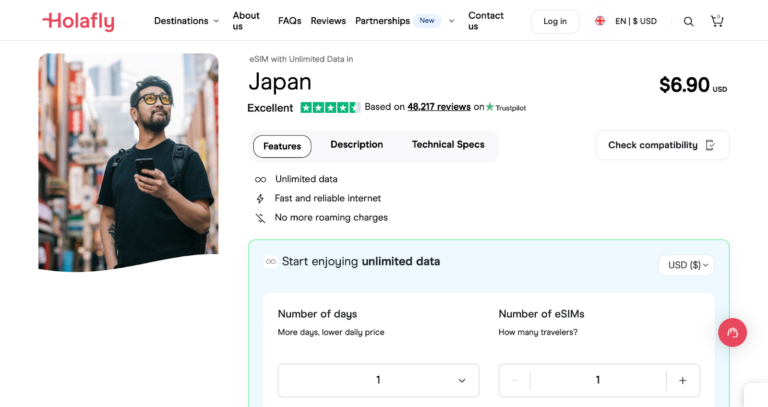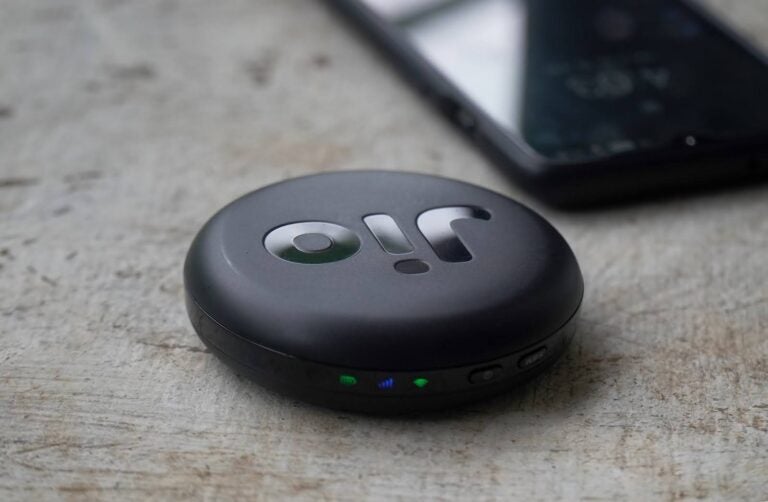How to get mobile internet in Japan in 2025?
Traveling to Japan, but not sure how to get reliable internet access? We’ve got you covered with this guide on the best mobile internet options in the country.
While international destinations like Japan are a great spot to vacation, figuring out how to navigate a new country (and its regulations) can be confusing. More so, if you don’t know the local language.
That’s why you need reliable mobile internet — to translate signage from the local language (Japanese) to English, figure out the subway routes, or even Google if you can get a selfie with a Geisha (you can’t!).
This guide explores the five most popular options of connecting to the internet in Japan for foreigners so you can figure out which one is the best fit for your trip.
How to get internet in Japan as a tourist
When visiting Japan, you have several options for getting internet access, including SIM cards, embedded SIMs (eSIMs), pocket WiFi devices, and free WiFi hotspots. Let’s explore and compare these below.
Data roaming
Data roaming is the most expensive way to connect to the internet in Japan. For example, Verizon, a popular US provider, charges $2.05 per MB for international data use on a pay-as-you-go basis — that’s $2,050 per GB.
Of course, Verizon offers prepaid international plans that make roaming data more affordable. The $100 international monthly plan gets you 20 GB of high-speed internet.
While you won’t be charged extra after you pass the data cap, your internet speed will slow down. This plan effectively costs about $5 per GB of high-speed internet, plus minutes and texts.
For shorter stays, Verizon’s TravelPass plan starts at $12 per day and includes unlimited data, calls, and texts.
There is, however, a 5 GB daily data cap that slows down your browsing speed once you exceed it, effectively costing $2.40 per GB of high-speed internet.
Installing a Japan eSIM
An embedded SIM card (eSIM) helps you escape the exorbitant charges while roaming in Japan. It’s the most convenient, cost-effective, and flexible option for you to get a reliable connection abroad.
eSIMs eliminate the need for a physical SIM card, making it easy to switch between carriers and plans without any hassle.
Activation is quick and done digitally, so you don’t need to visit a store or wait for a card to arrive. You can purchase them online before your trip and activate them upon landing in Japan by scanning a QR code.
Plus, eSIMs can store multiple carrier profiles, so you can have both a local Japanese plan and an international one on the same device.
While some local SIM providers like Mobal and Sakura Mobile provide an eSIM option, we recommend going for one of the best eSIMs for Japan. They come with better benefits and are geared toward tourists.
Holafly, for example, comes with unlimited data access at a maximum cost of just $6.90 per day. If you’re spending a month in Japan, then that’s unlimited data for $3.40 per day. In comparison, Mobal’s eSIM costs $25.57 for just 10 GB of data.
Holafly offers multi-destination plans for worldwide internet access. If you’re traveling from Japan to South Korea, the eSIM for Japan and Korea is a convenient choice. Your phone will automatically connect to the local network, so you can stay in touch without hassle. Prefer exploring the Great Wall or the Terracotta army? Then the eSIM for Japan and China is your best option.
Before purchasing an eSIM, check if your cell phone is eSIM-compatible. Phones launched before 2019 don’t work with eSIMs. iPhones from mainland China, Hong Kong, and Macao are also not eSIM-compatible.

Picking up a local SIM card
If your phone is not eSIM-compatible and you’re not bothered by the SIM-switching hassle once at the airport, you can opt for a prepaid Japan SIM card.
You can buy your SIM on arrival at the airport or a convenience store like 7-Eleven. An even better option would be to order it online before your trip as some SIM providers ship worldwide.
However, you might find switching SIM cards a little inconvenient, especially if your phone is not dual SIM. You’ll have to swap your regular SIM for the local one, which might make it hard for your friends and family to get a hold of you while you’re traveling.
In Japan, there are two types of SIM cards: data-only and data + voice. Of the many tourist SIM cards for tourists, only one — Mobal — provides both data and voice support. All others support only data. The other popular SIM providers are Sakura Mobile, IllJmio, and b-mobile.
| Provider | Price | Voice | Global shipping? |
|---|---|---|---|
| Mobal (Voice + data) | $19.73 USD (¥2,970) initial fee; $33 (¥4,950) for 7 GB/30 days | ✔️ | ✔️ |
| Mobal (Data only) | $31 (¥4,950) for 25 GB/8 days | ❌ | ✔️ |
| Sakura Mobile | Starts at $23 (¥3,500) for 5 days; unlimited data | ❌ | ❌ |
| IllJmio | Starts at $16.47 (¥2,480) for 3 GB/30 days | ❌ | ❌ |
| b-mobile | Starts at $13.15 (¥1,980) for 5 GB/10 days | ❌ | ❌ |
Here are two other things to keep in mind when getting a local Japan SIM:
- Ensure your phone is unlocked (not tied to a specific carrier). If locked, contact your carrier’s customer service team to unlock it. You may need to meet certain requirements, such as paying off your phone in full.
- Go for mobile voice and data if you plan to use certain apps in Japan like PayPay or ticketing platforms like LINE as they require a Japanese phone number.
Renting pocket WiFi
Another option — particularly if you’re traveling to Japan as a group or have several devices — is renting pocket WiFi. Although not the most affordable option, it’s a lot safer than public WiFi hotspots.
Renting a portable WiFi device in Japan typically involves reserving online before your trip, with options for airport pickup or hotel delivery.
When departing, you can drop it off at the airport or return it by mail, depending on the provider’s policies. For instance, NINJA WiFi offers airport pickup and return options, while Japan Wireless provides delivery to your hotel and return by mail.
| Travel tip: Specific procedures may vary by provider, so we advise you to check the details with your chosen service. |
There are more than a dozen pocket WiFi in Japan services in Japan, with the best options including:
- Ninja Wi-Fi: Starts at $13 (¥1,980) per day for the Unlimited data-only plan.
- Telecom Square WiFiBOX: Starts at $9.90 (¥1,390) per day for the Truly Unlimited data-only plan
Carrying a router around can be a bit of a hassle, and some companies mandate getting WiFi Router Insurance. Though helpful, it can add to the overall cost.

Connecting to free WiFi hotspots
Free public WiFi is available in most public spaces throughout urban Japan — from airports and train stations to restaurants and convenience stores.
Here’s how you can make the most of the free WiFi access in Japan. However, be cautious when using public WiFi networks, as they can be insecure and put your personal information at risk.
Airports
All major international airports in Japan — Haneda, Narita, and Kansai — provide free WiFi. This is great if you want to check your email when waiting in the baggage queue or to purchase your eSIM if you forgot to do that before traveling.
There’s usually a quick registration process (you don’t need to configure any advanced settings). And the speed depends on how congested a particular terminal is.
Hotels and restaurants
Most boutique hotels and Western-style restaurants like Starbucks or McDonalds provide free WiFi. However, it’s not as common in traditional inns like Ryoken, though some have WiFi access in main areas. So make sure to check when booking.
You’ll also find free WiFi in most coffee shops and pretty much all Manga Kissas (also called Netto Cafes) around Japan.

SoftBank Free WiFi Passport
This is a free service that allows tourists to access approximately 400,000 SoftBank hotspots across Japan. You can connect up to five devices, and you’ll need to get a new password every two weeks.
For the most convenience, consider downloading the Japan WiFi Auto-Connect app. You only have to register once and it’ll automatically connect to available networks as you move around. Saves you the hassle of having to constantly log into different free WiFi hotspots.
Though free WiFi is great for emergencies, we generally recommend skipping them if you can. They’re notoriously insecure, have slow speeds and some even come with time restrictions. But if you want to connect to one, use a VPN for an extra layer of protection.
Comparing different mobile internet options in Japan
Now that we’ve seen the different ways you can connect to the internet in Japan, let’s dig a little deeper — see how they compare to each other when it comes to other factors.
| Roaming data | Physical SIM | eSIM | Pocket WiFi | Free WiFi | |
|---|---|---|---|---|---|
| Value for money | ❌ | ✅ | ✅ | ❌ | ✅ |
| Convenience | ❌ | ❌ | ✅ | ❌ | ✅ |
| Safety | ✅ | ✅ | ✅ | ✅ | ❌ |
| Speed | ✅ | ✅ | ✅ | ✅ | ❌ |
| Reliability | ✅ | ✅ | ✅ | ✅ | ❌ |
In Japan, eSIMs are the most affordable option, with plans like Holafly offering unlimited data for around $20.90 for 5 days. Data roaming and pocket WiFi are the most expensive options, especially for heavy data users or longer stays.
Pocket WiFi also requires a security deposit and possibly insurance in Japan. Free WiFi is widely available in public spaces but can be unreliable and unsafe.
eSIMs are the most convenient in Japan, as they don’t require a physical card or extra device to get you online. Physical SIMs need to be purchased at stores, and pocket WiFi requires picking up a device at the airport or having it delivered to your hotel.
Free WiFi is available but can be inconvenient with repeated logins and frequent interruptions as you move outside of its range.
eSIMs, physical SIMs, and pocket WiFi provide fast and reliable internet throughout Japan. However, some physical SIMs may throttle speeds after reaching a certain data limit. Free WiFi is slower and less stable, especially in Japan’s crowded areas like train stations or shopping districts.
For heavy data usage or group travel, pocket WiFi can be a good option, but if you prefer simplicity and no extra devices, eSIMs are ideal.
Get uninterrupted internet in Japan with Holafly
It doesn’t matter if you’re in Japan for a day or a month, reliable mobile internet is a must-have. And the easiest way to go about this is by getting a Japan eSIM. Not only is it easy to activate, but it’s also budget-friendly — especially for heavy data users.
If you plan to stay for an extended period of time, then Holafly Connect is your ideal option. Choose from three monthly subscription plans (unlimited data, 25 GB, or 10 GB) and enjoy reliable, contract-free internet wherever you go!
Physical SIMs also work well if you require a Japanese phone number or voice and SMS services. However, higher data usage can increase your spending when compared to eSIMs.
And if you’re splurging on a pocket WiFi device, we suggest complementing it with an eSIM — particularly if you’re traveling as a group.
That way, you’ll have internet access even if you stray away from your friends. And if you choose a Holafly Japan eSIM, you can share 500 MB with others, plus, use the mobile app (available on both Android and iOS) to manage your plan on the go.
Japan offers some of the fastest internet speeds in the world, and these destinations also provide dependable mobile internet across Asia.
- Mobile internet in China
- Mobile internet in Hong Kong
- Mobile internet in Vietnam
- Mobile internet in Thailand
- Mobile internet in Singapore





 Language
Language 


















 No results found
No results found










